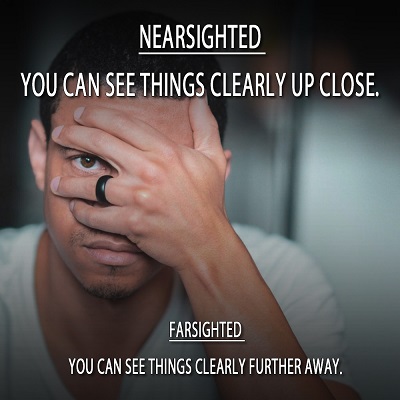 Having trouble reading those emails on your phone? Can’t see the road sign up ahead? If you’re noticing changes in your vision, it’s probably time to get your eyes checked. Over the course of our lives our eyes will change. It’s all part of the aging process.
Having trouble reading those emails on your phone? Can’t see the road sign up ahead? If you’re noticing changes in your vision, it’s probably time to get your eyes checked. Over the course of our lives our eyes will change. It’s all part of the aging process.
As an adolescent and young adult, your eyes don’t really level out until about age 20. Then you’ve got a good 20 years ahead with stable vision before the next change comes in and all the sudden your arms aren’t long enough to see what’s right in front of you!
If you needed corrective lenses early in life, chances are you’re going to experience several more gradual vision changes over the years.
What does it Mean to be Nearsighted?
If you can get a splinter out of your finger without requiring a magnifying glass, or if you can see things up close clearly, you are nearsighted.
The medical term for nearsightedness is myopia. The medical description is that nearsightedness is a refractive error that occurs usually because the eyeball has grown too long, believe it or not.
The light entering the eye is supposed to reach all the way to the retina at the back of the eyeball to focus but falls short and stops just before it gets there. If the light can’t reach that far now, it can’t properly focus. This makes far away vision blurry and close-up vision isn’t affected.
Fun fact: About 40% of the population in the United States is nearsighted.
What about Farsighted?
Picture yourself sitting on the couch in your living room. You can see the television across the room just fine, but the screen on your phone in your hand is blurry and hard to read. If you stretch out your arms as far as possible it gets a little better, but you still probably strain a little. This is a classic case of farsightedness.
Hyperopia is the fancy name for farsightedness and it affects about 25% of the population in the United States. If nearsightedness happens because the eyeball grew too long, the opposite must be true for farsightedness. Short eyeballs mean great distance vision!
The downside is that things up close, like getting out a splinter, are difficult to focus on because the light entering the eye jumps right over the retina due to the smaller eyeball.
Two Conditions, Same Symptoms
It’s fairly easy to discern the difference between nearsightedness and farsightedness based on vision alone. However, those aren’t the only symptoms you might notice.
Vision doesn’t typically change overnight. Oftentimes we may notice the other signs before we really know the true cause. You will probably experience unexplained headaches, usually felt near the eye socket, which could blamed on seasonal allergies or increased tension. Your eyes may feel more tired from straining. Squinting to see clearly is also very common.
Treatment Options
There are three treatment options available for both nearsightedness and farsightedness:
- Corrective eyeglasses
- Contact lenses
- Surgery
The exam to test your vision is the same no matter what treatment modality is catching your eye. The optometrist or ophthalmologist will likely not only check your vision but also your eye health by dilating your pupil and taking pictures of the inside of your eyeball.
The results of all the tests will give your eye care professional the whole picture and how best to address your chief complaint.
Your eye care professional will go over all of the available options with you and help you choose what’s right for your diagnosis. Health history, lifestyle and cost are huge factors to be weighed when deciding the treatment route, and more often than not people use a combination of therapies.
A 40-year-old might opt for LASIK to correct distance vision and use “readers” for things up close. An active person or sports enthusiast might opt for contact lenses during times of activity and still use glasses at home or when they aren’t training.
Additionally, monovision LASIK is an option for some patients. This is where one eye is surgically corrected. Eye care professionals have adopted the same type of method with contact lenses as well.
Basically, a person who is farsighted might have one eye corrected for nearsightedness, usually the non-dominant eye, and leave the other eye as is. An added perk for monovision LASIK is the cost is cut in half as the price for LASIK is “per eye”.
Receiving annual eye exams is imperative for overall eye health and wellness. Your eyes are incredibly small in relation to the important job they perform but need routine maintenance just most everything else. Don’t take any chances when it comes to eye health.






